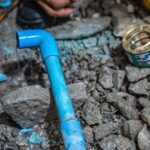Understanding the importance of proper ventilation
Ventilation plays a crucial role in maintaining a healthy indoor environment. It helps remove stale air, moisture, and pollutants from your home. Proper ventilation can reduce the risk of mold growth and improve overall air quality. The average person spends approximately 90% of their time indoors, making good ventilation essential for well-being.
There are several types of ventilation systems available for residential use. These include natural ventilation, mechanical ventilation, and hybrid systems. Natural ventilation relies on wind and temperature differences to move air, while mechanical systems use fans and ducts. Hybrid systems combine both methods for optimal performance.
Ventilation https://onninen.pl/en/products/Air-conditioning-and-ventilation/Ventilation systems can significantly impact energy efficiency. A well-designed system can help reduce heating and cooling costs by up to 30%. It’s important to consider factors such as climate, home size, and occupancy when choosing a ventilation solution.
Proper maintenance is key to ensuring your ventilation system operates effectively. Regular cleaning of vents, filters, and ducts can improve air flow and system efficiency. It’s recommended to have your ventilation system professionally inspected at least once a year.
Exploring ductless ventilation options
Ductless ventilation systems offer a flexible alternative to traditional ducted systems. These units are ideal for homes without existing ductwork or for adding ventilation to specific areas. Ductless systems are typically easier to install and can be more energy-efficient than ducted alternatives.
One popular type of ductless ventilation is the through-wall fan. These fans can move up to 200 cubic feet of air per minute, making them suitable for most residential applications. They are often used in bathrooms, kitchens, and laundry rooms to remove excess moisture and odors.
Ductless ventilation https://onninen.pl/en/products/Air-conditioning-and-ventilation/Ventilation/Ductless-ventilation systems can also include heat recovery ventilators (HRVs) and energy recovery ventilators (ERVs). These units exchange stale indoor air with fresh outdoor air while recovering up to 85% of the heat or cooling energy. This can lead to significant energy savings over time.
When choosing a ductless ventilation system, consider factors such as noise levels, energy efficiency ratings, and ease of maintenance. Some units come with additional features like humidity sensors or programmable timers for enhanced control.
The role of ventilation ducts and fittings
Ventilation ducts and fittings are essential components of many ventilation systems. They provide pathways for air to move throughout your home. Proper duct design and installation are crucial for system efficiency and effectiveness.
There are various types of ventilation ducts available, including flexible, rigid, and semi-rigid options. Flexible ducts are versatile and easy to install but may have higher air resistance. Rigid ducts offer better airflow but can be more challenging to install in tight spaces.
Ventilation ducts and fittings https://onninen.pl/en/products/Air-conditioning-and-ventilation/Ventilation/Ventilation-ducts-and-fittings come in different materials, such as galvanized steel, aluminum, and plastic. Each material has its advantages in terms of durability, cost, and insulation properties. For example, insulated ducts can reduce heat loss by up to 30% compared to uninsulated ducts.
Proper sizing of ducts and fittings is crucial for system performance. Undersized ducts can lead to increased energy consumption and reduced airflow. It’s recommended to consult with a professional to ensure your duct system is correctly designed and installed.
Improving indoor air quality through ventilation
Effective ventilation can significantly improve indoor air quality. It helps remove airborne pollutants, allergens, and excess moisture from your home. The Environmental Protection Agency (EPA) estimates that indoor air can be 2-5 times more polluted than outdoor air.
Ventilation systems can be equipped with filters to further enhance air quality. High-efficiency particulate air (HEPA) filters can remove up to 99.97% of airborne particles as small as 0.3 microns. This includes common allergens like dust, pollen, and pet dander.
Proper ventilation can also help control humidity levels in your home. Ideal indoor relative humidity should be between 30% and 50%. Maintaining appropriate humidity levels can reduce the risk of mold growth and improve overall comfort.
In addition to mechanical ventilation, natural ventilation methods can complement your system. Opening windows for 15-20 minutes daily can help refresh indoor air. This practice, known as air flushing, can be particularly beneficial in seasons with moderate temperatures.
Choosing the right ventilation system for your home
Selecting the appropriate ventilation system depends on various factors. These include your home’s size, layout, climate, and existing HVAC infrastructure. A professional assessment can help determine the most suitable solution for your needs.
Consider the following points when choosing a ventilation system:
- Energy efficiency ratings
- Noise levels
- Maintenance requirements
- Initial costs vs. long-term savings
- Compatibility with your existing HVAC system
For new constructions or major renovations, whole-house ventilation systems are often recommended. These systems can provide balanced ventilation throughout your home, ensuring optimal air quality and energy efficiency.
Remember that proper installation is crucial for any ventilation system. Professional installation can ensure your system operates at peak efficiency and complies with local building codes. This investment can lead to improved performance and longer system lifespan.





